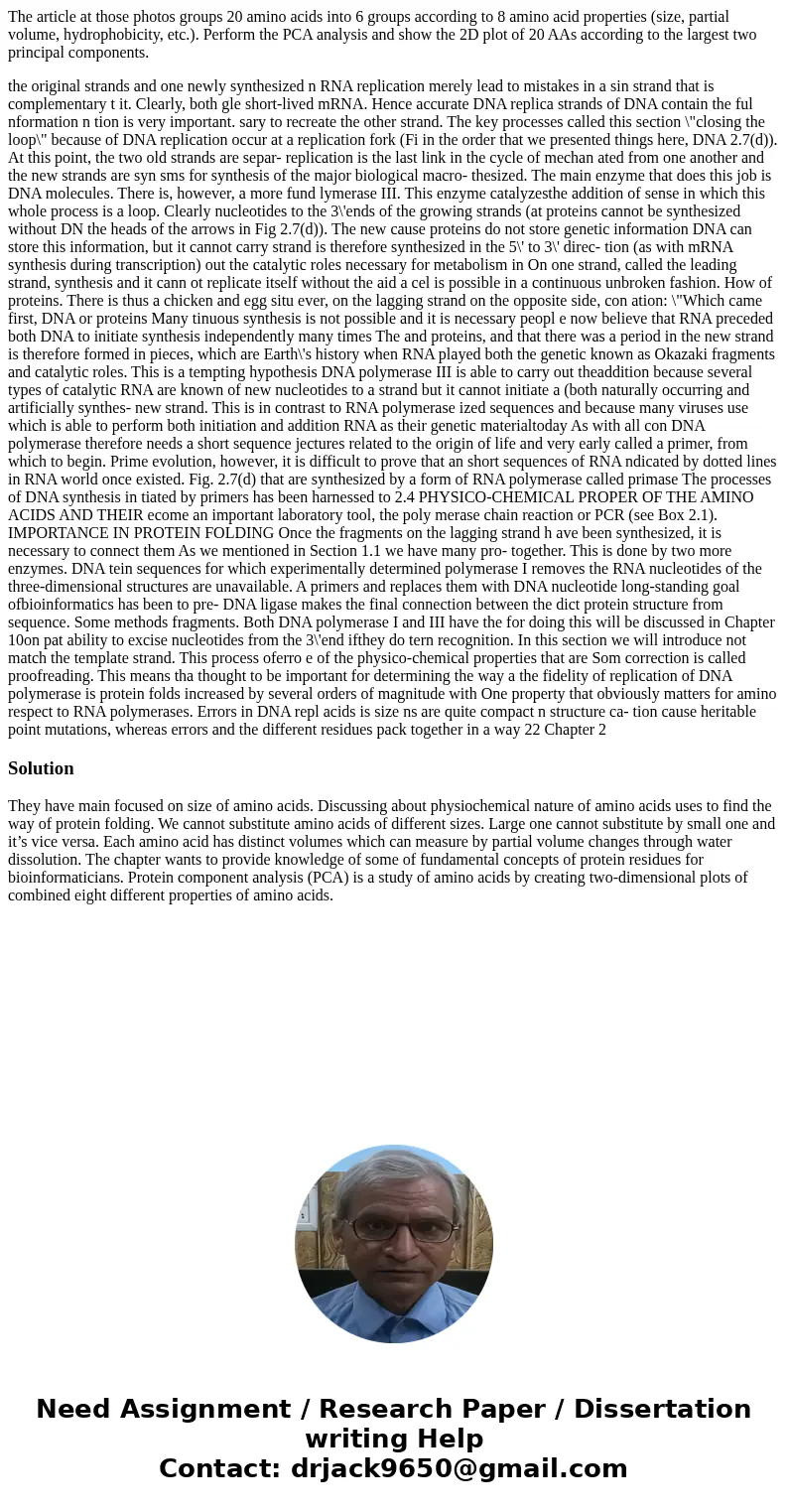The article at those photos groups 20 amino acids into 6 gro
The article at those photos groups 20 amino acids into 6 groups according to 8 amino acid properties (size, partial volume, hydrophobicity, etc.). Perform the PCA analysis and show the 2D plot of 20 AAs according to the largest two principal components.
the original strands and one newly synthesized n RNA replication merely lead to mistakes in a sin strand that is complementary t it. Clearly, both gle short-lived mRNA. Hence accurate DNA replica strands of DNA contain the ful nformation n tion is very important. sary to recreate the other strand. The key processes called this section \"closing the loop\" because of DNA replication occur at a replication fork (Fi in the order that we presented things here, DNA 2.7(d)). At this point, the two old strands are separ- replication is the last link in the cycle of mechan ated from one another and the new strands are syn sms for synthesis of the major biological macro- thesized. The main enzyme that does this job is DNA molecules. There is, however, a more fund lymerase III. This enzyme catalyzesthe addition of sense in which this whole process is a loop. Clearly nucleotides to the 3\'ends of the growing strands (at proteins cannot be synthesized without DN the heads of the arrows in Fig 2.7(d)). The new cause proteins do not store genetic information DNA can store this information, but it cannot carry strand is therefore synthesized in the 5\' to 3\' direc- tion (as with mRNA synthesis during transcription) out the catalytic roles necessary for metabolism in On one strand, called the leading strand, synthesis and it cann ot replicate itself without the aid a cel is possible in a continuous unbroken fashion. How of proteins. There is thus a chicken and egg situ ever, on the lagging strand on the opposite side, con ation: \"Which came first, DNA or proteins Many tinuous synthesis is not possible and it is necessary peopl e now believe that RNA preceded both DNA to initiate synthesis independently many times The and proteins, and that there was a period in the new strand is therefore formed in pieces, which are Earth\'s history when RNA played both the genetic known as Okazaki fragments and catalytic roles. This is a tempting hypothesis DNA polymerase III is able to carry out theaddition because several types of catalytic RNA are known of new nucleotides to a strand but it cannot initiate a (both naturally occurring and artificially synthes- new strand. This is in contrast to RNA polymerase ized sequences and because many viruses use which is able to perform both initiation and addition RNA as their genetic materialtoday As with all con DNA polymerase therefore needs a short sequence jectures related to the origin of life and very early called a primer, from which to begin. Prime evolution, however, it is difficult to prove that an short sequences of RNA ndicated by dotted lines in RNA world once existed. Fig. 2.7(d) that are synthesized by a form of RNA polymerase called primase The processes of DNA synthesis in tiated by primers has been harnessed to 2.4 PHYSICO-CHEMICAL PROPER OF THE AMINO ACIDS AND THEIR ecome an important laboratory tool, the poly merase chain reaction or PCR (see Box 2.1). IMPORTANCE IN PROTEIN FOLDING Once the fragments on the lagging strand h ave been synthesized, it is necessary to connect them As we mentioned in Section 1.1 we have many pro- together. This is done by two more enzymes. DNA tein sequences for which experimentally determined polymerase I removes the RNA nucleotides of the three-dimensional structures are unavailable. A primers and replaces them with DNA nucleotide long-standing goal ofbioinformatics has been to pre- DNA ligase makes the final connection between the dict protein structure from sequence. Some methods fragments. Both DNA polymerase I and III have the for doing this will be discussed in Chapter 10on pat ability to excise nucleotides from the 3\'end ifthey do tern recognition. In this section we will introduce not match the template strand. This process oferro e of the physico-chemical properties that are Som correction is called proofreading. This means tha thought to be important for determining the way a the fidelity of replication of DNA polymerase is protein folds increased by several orders of magnitude with One property that obviously matters for amino respect to RNA polymerases. Errors in DNA repl acids is size ns are quite compact n structure ca- tion cause heritable point mutations, whereas errors and the different residues pack together in a way 22 Chapter 2Solution
They have main focused on size of amino acids. Discussing about physiochemical nature of amino acids uses to find the way of protein folding. We cannot substitute amino acids of different sizes. Large one cannot substitute by small one and it’s vice versa. Each amino acid has distinct volumes which can measure by partial volume changes through water dissolution. The chapter wants to provide knowledge of some of fundamental concepts of protein residues for bioinformaticians. Protein component analysis (PCA) is a study of amino acids by creating two-dimensional plots of combined eight different properties of amino acids.

 Homework Sourse
Homework Sourse